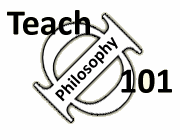Teach Philosophy 101
Free resources for
philosophy teachers!
"One of the most comprehensive, well-researched, and accessible guides for teachers that I have ever seen." James Lang, Chronicle of Higher Education (read full review of TΦ101)
Peer Instruction (PI)
Many of us struggle with a simple dilemma. On the one hand, we believe that true learning in philosophy grows out of discussion and dialogue. At the same time, economic realities dictate that many of our classes will be taught in large lecture formats. Peer Instruction (PI) is a technique that allows faculty members to combine lecture and discussion formats, also using innovative approaches to creating student interaction in large classes. For a philosophy specific discussion, see Butchart, Hanfield and Restall. "Using Peer Instruction to Teach Philosophy, Logic, and Critical Thinking," Teaching Philosophy 32:1, 2009.
Here Butchart describes the approach:
-
Basic Idea. The fundamental idea is simple. A typical class would start with a short lecture of about 15 minutes. After the initial lecture, the instructor poses a multiple choice question to the students. The students are then asked to register their opinion on the question, either by show of hands, voting with colored cards, or with "clickers." This poll will most likely produce one of several results. If the students all agree on the correct answer that shows mastery of the topic, the instructor can move on. If the students are mostly confused about the topic, the instructor may step back and review the topic, addressing the confusion. If the students disagree about the topic (with some having the correct answer and other exhibiting confusion) the students then participate in small group discussions and try to persuade each other of the correct answer. The instructor then repolls the students on the question, to see if students have now come to greater understanding of the topic, then responds accordingly.
-
Advantages. There are a number of obvious advantages to this method. First, polling the students (especially with clickers) provides an instant engagement from the students. TΦ101 has been amazed by the way students perk up when they get to enter an opinion with clickers and instantly see how other students answered. At the same time, this method allows for good feedback to the instructor, to see whether students are grasping the material. It also is a highly inclusive technique, since (especially with clickers) all of the students will be participating.
-
Techniques. The simplest way to get the student feedback is to ask for a show of hand vote. The problem with this is that many students typically watch how other students vote before raising their own hand. Another possibility is to distribute colored flash cards to students, marked "A","B," "C," etc. It is harder for students to see how the other students voted and easier for the instructor to tally the results. A far superior method is to use clickers. This technology is surprisingly easy to use, not expensive compared to typical textbooks, and, at any rate, many students will already have clickers for their other classes. Here the results are completely anonymous (so students give much more honest answers), can be instantly tallied and displayed, and, furthermore, our increasingly high-tech students really enjoying the whole process.
-
Constructing questions. Of course, the artistry in doing all of this is constructing the questions. There are suggestions at the end of the Butchart, Hanfield and Restall paper.
There are many ways to use peer instruction. Here are some other possible approaches:
-
Review sessions ahead of an exam: Have students work together in groups to complete a pre-exam review using a study guide. This gives students opportunities to correct each other's misconceptions and discuss course content.
-
Peer review of paper drafts: Most instructors don't have time to read drafts of every student's paper. A good approach is to have students conduct an in class peer review. Placing students in groups of 3-4 is a great approach in that it encourages them to get a head start on the assignment and having to turn in a draft and demonstrate that changes were made can discourage the submission of AI generated work. In class paper review does require some prep work on your end. You want to give your students some practice with the review process, as well as a tool for conducting the review. E.g., give students the rubric you plan to grade their papers with, or a list of features to look for, such as thesis statement, use of evidence, etc. Prior to an in-class peer review, it is a good idea to have students read and discuss sample papers to give them an idea of a strong paper, as well as how a paper can be improved.
-
Discussion/review of homework assignments: An easy way to incorporate peer review is to have students compare answers on an homework assignment. E.g., if students had to complete short answer questions, perform proofs, or map arguments, having them compare results at the beginning of class is a good way for students to learn from each other and reduce your own grading burden.
-
In class quiz: Have students take a short in class quiz of some kind and then form groups and work together to arrive at the right answer for each question.
Sources:
Butchart, Hanfield and Restall. "Using Peer Instruction to Teach Philosophy, Logic, and Critical Thinking," Teaching Philosophy 32:1, 2009.
Author: John Immerwahr
Update: October 4, 2015 (E. Tarver); 11/24/2025--David Sackris
